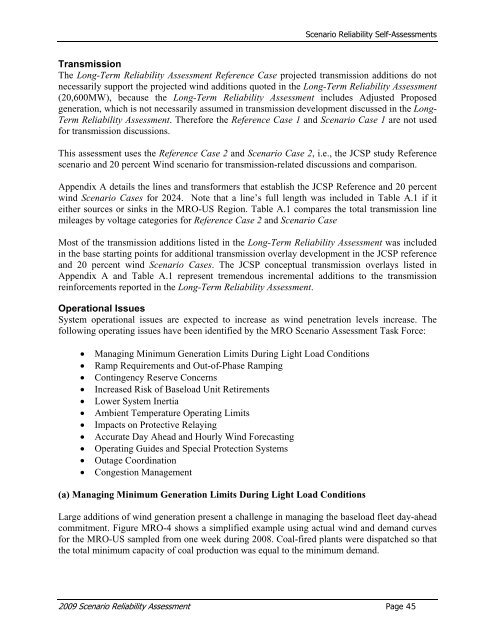2009 Scenario Reliability Assessment - NERC
2009 Scenario Reliability Assessment - NERC
2009 Scenario Reliability Assessment - NERC
- No tags were found...
Create successful ePaper yourself
Turn your PDF publications into a flip-book with our unique Google optimized e-Paper software.
<strong>Scenario</strong> <strong>Reliability</strong> Self-<strong>Assessment</strong>sTransmissionThe Long-Term <strong>Reliability</strong> <strong>Assessment</strong> Reference Case projected transmission additions do notnecessarily support the projected wind additions quoted in the Long-Term <strong>Reliability</strong> <strong>Assessment</strong>(20,600MW), because the Long-Term <strong>Reliability</strong> <strong>Assessment</strong> includes Adjusted Proposedgeneration, which is not necessarily assumed in transmission development discussed in the Long-Term <strong>Reliability</strong> <strong>Assessment</strong>. Therefore the Reference Case 1 and <strong>Scenario</strong> Case 1 are not usedfor transmission discussions.This assessment uses the Reference Case 2 and <strong>Scenario</strong> Case 2, i.e., the JCSP study Referencescenario and 20 percent Wind scenario for transmission-related discussions and comparison.Appendix A details the lines and transformers that establish the JCSP Reference and 20 percentwind <strong>Scenario</strong> Cases for 2024. Note that a line’s full length was included in Table A.1 if iteither sources or sinks in the MRO-US Region. Table A.1 compares the total transmission linemileages by voltage categories for Reference Case 2 and <strong>Scenario</strong> CaseMost of the transmission additions listed in the Long-Term <strong>Reliability</strong> <strong>Assessment</strong> was includedin the base starting points for additional transmission overlay development in the JCSP referenceand 20 percent wind <strong>Scenario</strong> Cases. The JCSP conceptual transmission overlays listed inAppendix A and Table A.1 represent tremendous incremental additions to the transmissionreinforcements reported in the Long-Term <strong>Reliability</strong> <strong>Assessment</strong>.Operational IssuesSystem operational issues are expected to increase as wind penetration levels increase. Thefollowing operating issues have been identified by the MRO <strong>Scenario</strong> <strong>Assessment</strong> Task Force:Managing Minimum Generation Limits During Light Load ConditionsRamp Requirements and Out-of-Phase RampingContingency Reserve ConcernsIncreased Risk of Baseload Unit RetirementsLower System InertiaAmbient Temperature Operating LimitsImpacts on Protective RelayingAccurate Day Ahead and Hourly Wind ForecastingOperating Guides and Special Protection SystemsOutage CoordinationCongestion Management(a) Managing Minimum Generation Limits During Light Load ConditionsLarge additions of wind generation present a challenge in managing the baseload fleet day-aheadcommitment. Figure MRO-4 shows a simplified example using actual wind and demand curvesfor the MRO-US sampled from one week during 2008. Coal-fired plants were dispatched so thatthe total minimum capacity of coal production was equal to the minimum demand.<strong>2009</strong> <strong>Scenario</strong> <strong>Reliability</strong> <strong>Assessment</strong> Page 45
















